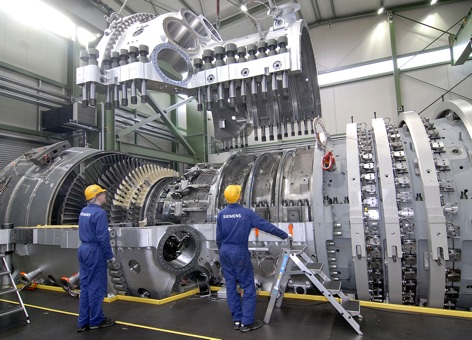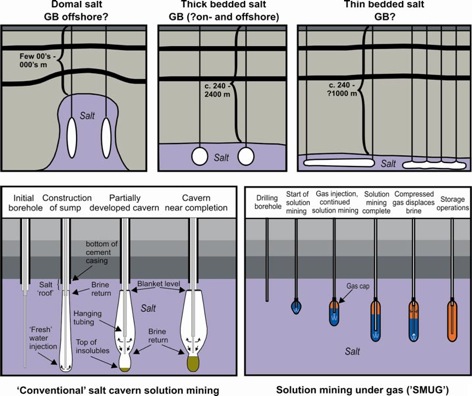Over the next few decades, the way that electricity is generated in the UK is predicted to change considerably. Nuclear power stations will make a larger contribution to the total generating capacity, and fossil fuel stations will increasingly be built or retrofitted with equipment to capture their carbon dioxide emissions so that they can be compressed and stored, most likely in offshore repositories below the sea bed.
Meanwhile, more renewable generating capacity, based around wind farms and tidal generation and possibly wave power, will be coming on stream from sites around the UK’s coast.
This represents a problem. Nuclear power is inflexible — reactors work best when producing a stable amount of thermal energy throughout the day, which has to be fed to the boilers to raise steam. Similarly, although conventional fossil-fuelled turbines can be operated flexibly, the addition of CCS technology again means that they are best run at as near a constant rate as possible.
But renewables are, by their nature, variable; the tides predictably so, the wind notoriously not. This means that some kind of variable capacity is going to be needed to top up the Grid when renewables are falling short, whether that variation is regional or national.
One answer currently being studied by the Energy Technologies Institute (ETI) might be a national network of turbines configured to run on hydrogen, which would be generated by gasification of gas and coal and stored underground in salt caverns, mainly offshore. This, the ETI’s CCS programme manager Andrew Green told The Engineer, has would have several advantages, providing a flexible generating capacity while still making the best use of capital plant which prefers to be operated at full capacity.

The ETI operates as a public-private partnership bringing together energy industry majors to accelerate the development of low-carbon energy technologies, often by doing the groundwork to remove some of the uncertainty around them and give financiers more confidence to invest in their development. This, so the strategy goes, is key to helping innovative green technologies bridge the gap from conceptual research to a deployable commercial offering.
‘We’re developing most of the ETI’s strategy on something called the Energy Systems Modelling Environment or ESME, which is a national tool that looks at the whole energy system — generation, distribution, storage and consumption — and looks at finding the lowest-cost solution,’ Green explained. ‘What it indicates is that systems which adopt flexible generation but make the most effective use of capital equipment are extremely highly valued, because they’re the best way to complement baseload nuclear and intermittent renewables.’
‘These sorts of systems would be of a similar scale to a commercial power station, and this is part of the general roll-out of CCS
Andrew Green, ETI
The advantage of configuring turbines to burn hydrogen, rather than to operate directly on fossil fuels, is that it strips the carbon away from the fuel and captures it at source, rather than having to capture it post-combustion. Gasification — converting fossil fuels (which might already be gases) into CO2 and hydrogen — is a well-established process, and Green explained that gasifiers, like most chemical plant, are best operated at a constant baseload, whereas gas turbines, if freed from the integration that’s necessary in a CCS-equipped power station, can be operated flexibly with no efficiency penalty, allowing them to be run to fill in for low production periods for renewables.
This strategy is being formulated assuming that a CCS infrastructure is in place, Green stressed. ‘You would be looking to store the CO2 in a depleted oil or gas well, or saline aquifer, offshore,’ he said. ‘These sorts of systems would be of a similar scale to a commercial power station, and this is part of the general roll-out of CCS.’
Sites suitable for storing CO2 are no good for hydrogen, however, and this is where salt caverns come in. Large salt deposits occur in many locations in and around the UK — reserves in the Northwest have supplied a large chemicals sector for many years — and salt caverns, which can be made by dissolving away a void within the salt stratum, using techniques originally developed for salt-mining by ICI, have the right sort of volume and strength to store a significant amount of pressurised hydrogen safely, Green said.
‘One of the issues is whether you can store the hydrogen at a suitable pressure,’ he explained. ‘It will come out of the gasifier plant under pressure and you don’t want to lose energy, either in letting it down or in compressing it further.’
Of course, whenever hydrogen is mentioned, safety concerns are close behind: the gas is, after all, flammable, explosive and difficult to contaon because of the very small dimensions of hydrogen molecules. ‘We’re looking carefully at security,’ Green said, explaining that the caverns would be formed so that they are still surrounded by thick, strong deposits of crystalline salt, which can contain hydrogen safely. ‘If these facilities were onshore, they’d be in highly industrialised areas, away from anywhere residential, but they’d be more likely to be offshore.’

The ETI is working with the British Geological Survey (BGS) for this part of the project, surveying possible sites for salt caverns and establishing the potential for hydrogen storage. Another part of the project, which engineering contractor Foster Wheeler, aims to investigate the scale, configuration and cost of the gasifiers and turbines needed to provide the generation capacity which would be needed for such a system — tens of gigawatts, Green estimates, with each installation providing about a gigawatt
‘We launched this five-year project to get a better idea of how these systems might look in detail,’ Green said. ‘The costs are very important — putting in storage increases the cost, for example, so you have to balance that against the potential benefit. When we have an idea of the cost and technical issues, it’ll give us some idea of the key development issues that might be faced if you were going to use such systems, and at the very least it’ll provide us with more robust costings that we can use in our energy system modelling.’
One such development issue might be the turbines that would drive the generators, but Green pointed out technology is available. ‘There are potentially two sorts of turbine that might work,’ he said. ‘There is they type that’s currently used in gasifier-fed power stations, and there’s aero-derived turbines which are similar to jet engines.’
Another possibility for such systems is to use power generated by renewable capacity to electrolyse seawater during times of low demand but high production — such as night-time high tides and especially windy days — and use the caverns directly as energy storage. ‘That could be a minor use for the systems,’ Green said, ‘but we’re anticipating that gasifier-linked operation would be the majority application.’
Green is keen to point out that this project, projected to cost £5million, is just a first step in a long process. ‘If successful, the benefits could potentially be huge,’ he said.




IEA report claims batteries are ‘changing the game’
Oh I don't know. The typical waiting time outside of A&E for admitting patients would give them plenty of time to recharge … ?